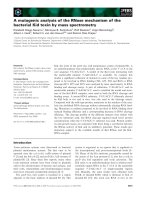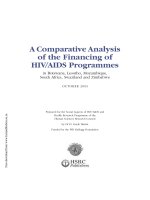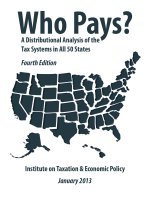A text analysis of “The 2007 commencement speech by Bill Gates at Harvard University ” and “The 2014 commencement speech by Bill and Melinda Gates at Stanford University” on the De Beaugrande framework
Bạn đang xem bản rút gọn của tài liệu. Xem và tải ngay bản đầy đủ của tài liệu tại đây (285.59 KB, 13 trang )
<span class='text_page_counter'>(1)</span><div class='page_container' data-page=1>
<b>VIETNAM NATIONAL UNIVERSITY, HANOI </b>
<b>UNIVERSITY OF LANGUAGES AND INTERNATIONAL STUDIES </b>
<b>FACULTY OF POST-GRADUATE STUDIES </b>
<b>NGUYỄN LINH CHI </b>
<b>A TEXT ANALYSIS OF “THE 2007 COMMENCEMENT SPEECH BY BILL </b>
<b>GATES AT HARVARD UNIVERSITY” AND “THE 2014 </b>
<b>COMMENCEMENT SPEECH BY BILL AND MELINDA GATES AT </b>
<b>STANFORD UNIVERSITY” ON THE DE BEAUGRANDE FRAMEWORK </b>
<i><b> (Phân tích văn bản “Bài phát biểu của Bill Gates trong lễ tốt nghiệp năm 2007 tại </b></i>
<i><b>Đại học Harvard ” và “Bài phát biểu của Bill và Melinda Gates trong lễ tốt nghiệp năm </b></i>
<i><b>2014 tại Đại học Stanford” bằng khung lý thuyết của De Beaugrande) </b></i>
<b>M.A. Minor Program Thesis </b>
<b>Major: English Linguistics </b>
<b>Code: 60220201 </b>
</div>
<span class='text_page_counter'>(2)</span><div class='page_container' data-page=2>
<b>VIETNAM NATIONAL UNIVERSITY, HANOI </b>
<b>UNIVERSITY OF LANGUAGES AND INTERNATIONAL STUDIES </b>
<b>FACULTY OF POST-GRADUATE STUDIES </b>
<b>NGUYỄN LINH CHI </b>
<b>A TEXT ANALYSIS OF “THE 2007 COMMENCEMENT SPEECH BY BILL </b>
<b>GATES AT HARVARD UNIVERSITY” AND “THE 2014 </b>
<b>COMMENCEMENT SPEECH BY BILL AND MELINDA GATES AT </b>
<b>STANFORD UNIVERSITY” ON THE DE BEAUGRANDE FRAMEWORK </b>
<i><b> (Phân tích văn bản “Bài phát biểu của Bill Gates trong lễ tốt nghiệp năm 2007 tại </b></i>
<i><b>Đại học Harvard ” và “Bài phát biểu của Bill và Melinda Gates trong lễ tốt nghiệp năm </b></i>
<i><b>2014 tại Đại học Stanford” bằng khung lý thuyết của De Beaugrande) </b></i>
<b>M.A. Minor Program Thesis </b>
<b>Major: English Linguistics </b>
<b>Code: 60220201 </b>
<b>Supervisor: Assoc. Prof. Dr. Ngô Hữu Hoàng </b>
</div>
<span class='text_page_counter'>(3)</span><div class='page_container' data-page=3>
i
<b>TABLE OF CONTENTS </b>
</div>
<span class='text_page_counter'>(4)</span><div class='page_container' data-page=4>
ii
<b>CHAPTER III: ANALYSIS OF TWO COMMENCEMENT SPEECHES BY </b>
<b>BILL GATES ON TEXTUALITY STANDARDS ... Error! Bookmark not defined. </b>
</div>
<span class='text_page_counter'>(5)</span><div class='page_container' data-page=5>
I
<b>PART A: INTRODUCTION </b>
<b>1. Rationale of the study </b>
When someone forms a text they are often concerned with their text’s effect in
practice; hence, there have been a number of theories that assist one in creating a
successful text. As an English linguistics researcher, the thesis writer realizes that
the framework by De Beaugrande (1981) is a reliable foundation on which she is
able to analyze a text, which significantly contributes to her Master’s degree
accomplishment. In addition, that theory eventually helps the thesis writer improve
the capability of producing and evaluate invaluable texts in her teaching career and
devotes to the study of text linguistics in particular as well as English as an
international language in general. De Beaugrande and Dressler suggest “Seven
Standards of Textuality” (cohesion, coherence, intentionality, acceptability,
informativity, situationality, and intertextuality) and hypothesized that, if any one of
them was not met, the text would not be communicative. Undoubtedly, those seven
criteria considerably contribute to the success of a text in general and two speeches
in particular - The 2007 commencement speech by Bill Gates at Harvard University
and The 2014 commencement speech by Bill and Melinda Gates at Stanford
University. They are considered to be the most profound, inspirational speeches at
graduation ceremonies presented by Bill Gates – one of the world’s leading
individuals. Accordingly, the thesis writer felt the necessity to conduct a study in
respect of seven standards of textuality and employ theoretical background to shed
<i>light on the reputation of The 2007 commencement speech by Bill Gates at Harvard </i>
<i>University and The 2014 commencement speech by Bill and Melinda Gates at </i>
<i>Stanford University. </i>
<b>2. Aims of the study </b>
</div>
<span class='text_page_counter'>(6)</span><div class='page_container' data-page=6>
II
linguistics. The selected text to be explored is two well-known commencement
speeches by Bill Gates at Harvard University in 2007 and at Stanford in 2014. This
research is expected to be useful for those who are interested in producing a
powerful and interactive text and an impressive commencement speech based on
seven standards of textuality.
<b>3. Research question </b>
In order for the aforementioned aims to be achieved, the research attempts to
<i>answer the following question: How do the two commencement speeches addressed </i>
<i>by Bill Gates in 2007 and 2014 fulfill the standards of textuality in the De </i>
<i>Beaugrande framework? </i>
<b>4. Scope of the study </b>
It is a common knowledge that there are numerous factors that make a speech
memorable such as non-verbal language, the tone of voice, the idea, the cadence of
the words and the rhythm of the sentences and so forth. However, this thesis
provides a very modest analysis on the success of two commencement speeches by
Bill Gates in 2007 and 2014, respectively, by employing De Beaugrande
framework. Since cohesion and coherence, which have been priorly discussed in
detail by many researchers, may require a more elaborate and extensive study, the
scope of this MA thesis is narrowed down to five instead of seven standards of
textuality, which are intentionality, acceptability, informativity, situationality, and
intertextuality.
This study is conducted with the hope that the readers will have a thorough
grasp of De Beaugrande framework which is concerned with seven criteria of
textuality. Practically, the thesis may assist someone to a certain extent in preparing
and delivering a persuasive speech to record considerable achievements in society.
<b>5. Design of the study </b>
</div>
<span class='text_page_counter'>(7)</span><div class='page_container' data-page=7>
III
Part A: Introduction
This part includes the rationale, aims of the study, research question, and scope of
the study as well as the structure of the thesis.
Part B: Development
<i>Chapter I: Theoretical Background. This chapter deals with the theoretical </i>
background that inspires the thesis. This chapter provides some related studies as
well as the thorough literature review of five standards of textuality in which each
of those criteria will be discussed in detail.
<i>Chapter II: Methodology. This chapter discusses the research approach, research </i>
methods of the study. Moreover, this chapter provides information about data
collection procedure.
<i>Chapter III: The analysis of two speeches on De Beaugrande framework. This </i>
chapter analyzes the collected data then withdraws the final conclusions of the
thesis. Further discussion on findings will be presented as well as the personal
interpretations and comments from the thesis writer.
Part C: Conclusion
</div>
<span class='text_page_counter'>(8)</span><div class='page_container' data-page=8>
IV
<b>PART B: DEVELOPMENT </b>
<b>CHAPTER I: THEORETICAL BACKGROUND </b>
The literature review of the thesis is the compilation of written and published
knowledge on the topic of De Beaugrande framework regarding some standards of
textuality. The review is drawn from previous studies done by famous linguists and
prior linguistic scholars.
<b>1. </b> <b>Text </b>
<b>1.1. Definition of a text </b>
As Beaugrande and Dressler (1981, p.3) stated, a text is a “naturally occurring
manifestation of language, i.e. as a communicative language event in a context.
The surface text is the set of expressions actually used; these expressions make
some knowledge explicit, while other knowledge remains implicit, though still
applied during processing.”
Werlich (1976, p.23) defined that “a text is an extended structure of syntactic
units [i.e. text as super-sentence] such as words, groups, and clauses and textual
units that is marked by both coherence among the elements and completion ...” He
also distinguished between “a text” and “a non-text” which consists of random
sequences of linguistic units such as sentences, paragraphs, or sections in any
temporal and/or spatial extension.
Halliday and Hasan (1976, p.1-2) claimed that “text” is a term “used in
linguistics to refer to any passage - spoken or written, of whatever length, that does
form a unified whole [….] A text is a unit of language in use. It is not a grammatical
unit, like a clause or a sentence; and it is not defined by its size [….] A text is best
regarded as a semantic unit; a unit not of form but of meaning.”
</div>
<span class='text_page_counter'>(9)</span><div class='page_container' data-page=9>
V
Text linguists generally agree that text is the natural domain of language, but
they still differ in their perspectives of what constitutes a text. This variance is
mainly due to the different methods of observations of different linguists, and as
such, the definition of text is not yet concrete.
A text contains meaning which is open to interpretation and most discussions
of “text” revolve around interpretation of “texts”, rather than a definition of the term
itself. However the word “text” is exploited in linguistics to imply that the words,
phrases, lines or sentences of which it consists have not been arranged this way by
chance, but have been produced by a person and with certain kinds of intentions as
stated in Halliday and Hasan (1976). A text may be prose or verse, dialogue or
monologue. It may be anything from a single proverb to a whole play, from a
momentary cry for help to an all-day discussion on a committee. That is,
geographical length is not important for a text, for example:
- a single word: “DANGER” on a warning sign.
- a stretch of language even though not a sentence: “NO SMOKING” printed on a
wall.
<i>- plays or novels: Hamlet, Great Expectations, etc. </i>
A text is a unit of language in use. It is not a lexico-grammatical unit like a
clause or a sentence, and it is not defined by size. We cannot mathematically count
that a text has two or three or how many sentences. A text does not consist of
sentences. It is realized by, or encoded in sentences.
A text is best regarded as a semantic unit, a unit not of form but of meaning.
Thus it is related to a clause or sentences not by size but by realization, the coding
of one symbolic system in another.
</div>
<span class='text_page_counter'>(10)</span><div class='page_container' data-page=10>
VI
The thesis writer is in favor of the definition by De Beaugrande & Dressler
(1981, p.3) in which a text “... will be defined as a communicative occurrence which
meets seven standards of textuality”. The seven standards referred to are cohesion,
coherence, intentionality, acceptability, informativity, situationality and
intertextuality.
<b>1.2. </b> <b>Some major features of a text </b>
A text is a stretch of language which seems appropriately coherent in actual
use. That is, the text “coheres” in its real-world context, semantically and
pragmatically, and it is also internally or linguistically coherent. Quirk et al. (1985,
p.1423) mentioned some features of a text in their work “A Comprehensive
Grammar of the English Language” as the following:
- Text is defined as language in use, i.e. in terms of function and situation
- Text is internally structured
- A text must display a “cohesive harmony” and logics (make sense with
respect to the outer world)
- The basic unit of a text: sentence
- No structural patterns as in sentences (e.g. an interrogative sentence but not
an interrogative text)
- A text – unlike sentence – is not a grammatical unit but rather a semantic and
even a pragmatic one
<b>2. </b> <b>Texture versus Text </b>
According to definitions of text, particularly that of Halliday and Hasan
(1976), it can be inferred that there must be, beyond the intuitive level, a linguistic
distinction (at least in principle) between a text and non-text, and that distinction is
based upon meaning. A text makes sense, whereas a non-text may be nonsensical.
The difference lies in the presence (or absence) of what is called “texture”.
</div>
<span class='text_page_counter'>(11)</span><div class='page_container' data-page=11>
VII
<b>REFERENCES </b>
<i>Ansari, T. (2013). Dimensions in Discourse: Elementary to Essentials. Xlibris </i>
Corporation.
<i>Brown, G. & G. Yule. (1983). Discourse Analysis. Cambridge: Cambridge </i>
University Press.
<i>Carstens, W.A.M. (1997). Afrikaanse tekslinguistiek „n Inleiding. (Afrikaans text </i>
<i>linguistics. An Introduction). Pretoria: JL van Schaik Akademies. </i>
<i>Crystal, D. (1992). An Encyclopedic Dictionary of Language and Languages. </i>
Oxford: Basil Blackwell.
<i>De Beaugrande, R.., Dressler, W. U. (1981). Introduction to text linguistics. </i>
London/ New York: Longman.
<i>Donnelly, C. (1994). Linguistics for writers. Buffalo: SUNY Press. </i>
<i>Fairclough, N. (1992). Discourse and Social Change. Cambridge: Polity Press. </i>
<i>Fowler, R. (1991). Language in the News: Discourse and Ideology in the </i>
<i>Press. London/ New York: Routledge. </i>
<i>Gass, S.M., Mackey, A. (2005). Second language research: Methodology and </i>
<i>Design. London: Lawrence Erlbaum Associates, Publishers. </i>
<i>Halliday, M.A.K., Hasan, R. (1976). Cohesion in English. London: Longman. </i>
<i>Leeuwen van, Theo (1993). Genre and Field in Critical Discourse Analysis: A </i>
<i>Synopsis. [In] Discourse and Society. Sage, vol. 4 (2). </i>
<i>Łuczak, M., Jacek, S. (1999). Drogi krzyżowe. Wprost No. 34, 22 August. </i>
<i>Quirk, R., Geenbaum, S., Leech, G., Svartvik, J. (1985). A Comprehensive </i>
<i>Grammar of the English Language. Essex, Pearson: Longman. </i>
<i>Renkema, J. (1993). Discourse studies. An introductory textbook. Amsterdam/ </i>
Philadelphia: John Benjamins.
</div>
<span class='text_page_counter'>(12)</span><div class='page_container' data-page=12>
VIII
<i>Van Dijk, T.A. (1972). Some Aspects of Text Grammars: A Study in Theoretical </i>
<i>Linguistics and Poetics. The Hague: Mouton. </i>
<i>Werlich, E. (1976). A text grammar of English. Heidelberg: Quelle & Meyer. </i>
<b>Online sources: </b>
<i>Birdal, A. (2010). An analysis of a text in terms of the seven standards of </i>
<i>textuality:The text The Text: “Baucis and Philemon” by Edith Hamilton. Retrieved </i>
December 6, 2014 from
<i>Harvardgazette. (2007). Remarks of Bill Gates, Harvard Commencement 2007. </i>
Retrieved December 5, 2014 from
<i>Jefferies, S. C. (1999). Descriptive Research. Retrieved August 17, 2014 from </i>
<i>Persada, S. (2011). Comparing personal deixis used by president Megawati and </i>
<i>president by in “Hari Kebangkita Nasional” speech that represent speaker </i>
<i>position. Retrieved August 17, 2014 from </i>
/>ON_TO_POLITENESS_FUNCTION.pdf
<i>Piotr P. C. (2009). Principles of Textual Communication. On the Basis of Polish </i>
<i>Press Reports after President Obama‟s 2009 Inauguration. Styles of </i>
Communication, Vol 1, No 1. Retrieved January 14, 2015 from
</b>
<i>Seward, Z. M. (2007). Bill Gates To Speak at Commencement. Retrieved December </i>
12, 2015 from
<i>Stanford Report. (2014). Text of the 2014 Commencement address by Bill and </i>
<i>Melinda Gates. Retrieved December 5, 2014 from </i>
</div>
<span class='text_page_counter'>(13)</span><div class='page_container' data-page=13>
IX
<i>The George C. Marshall Foundation. (2015). The Marshall Plan Speech. Retrieved </i>
December 6, 2015 from
</div>
<!--links-->
<a href='v- /> Tài liệu Báo cáo khoa học: A comparative analysis of the time-dependent antiproliferative effects of daunorubicin and WP631 pdf
- 7
- 582
- 0








